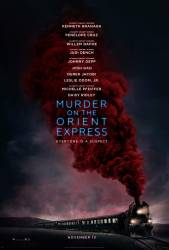Factual error: Both the Yugoslav police officers Poirot is speaking to at the end are black. The chances of a black person serving in the Yugoslav police in the 1930s were zero.
Factual error: Before arriving at Brod station the train goes through high mountains. Between Belgrade (Serbia) and Brod (Bosnia and Croatia) it is all flat with no mountains around.
Factual error: Brod railway station is not (and never was) an isolated railway station with mountains behind it. No mountains are visible from it but the town and fortress are nearby and easily visible from the station.
Factual error: At beginning at the Wailing Wall in Jerusalem in 1936, we see the large plaza at the Western Wall. In 1936 this was only a narrow lane. The plaza was enlarged only after June 1967.
Factual error: The chefs on the Orient Express in the movie are female. Women did not work as chefs in the 1930s and none of the train crew would have been female in any case.
Factual error: When facing the western wall, Poirot orders a man to guard the south gate. The man runs to the left of the frame. The western wall is what remains of the old temple, which lay to the east of the current plaza, so when you're standing looking at the wall you're actually facing east, not west. The man runs the wrong way.
Continuity mistake: The table outside the train, where Hercule and Ms. Debenham were sitting at with the coffeepot and cups, is missing when they stand up and return to the train.
Factual error: In the breakfast scene involving eggs, Poirot refers correctly in French to one egg "un oeuf" (pronounced "erf"). However, Branagh mispronounces the plural. He said "oeufs" ("erfs"). The correct pronounciation omits the f and the s, correctly sounding like "euhh." Poirot is French-speaking so would know better.
Continuity mistake: At the end when Poirot gets off the Orient Express, he uses the standalone stairs placed close to the rails. As he walks off, the shot changes to the side where he meets a police officer. The shot widens and the stairs are now placed well away from the rails.
Continuity mistake: In the last scene at the Wailing Wall, Poirot's white pocket square is on the right side of his jacket...where no pocket exists. In the next scene, it's on the correct, left side. Then again, on the ferry, it's back on the right.
Factual error: Poirot refers to the senior police officer in Jerusalem as the Chief Inspector of Police and implies that he commands the police in Jerusalem. The Palestine Police had no rank of Chief Inspector. The three stars worn by the officer were the insignia of an Assistant Superintendent of Police, the entry-level rank for gazetted officers. The head of the Jerusalem police was a District Superintendent of Police, two ranks higher. As Poirot is famously a stickler for detail, it's certainly not a character mistake.
Factual error: The Orient Express had a restaurant coach, four sleeping coaches and two baggage cars, and carried 58 passengers, far larger than the train depicted. There was a conductor always on duty in every sleeping coach and they worked shifts, so more than four would be carried; it's stated that Michel is the only conductor on board.
Character mistake: Poirot identifies Prof. Hardman's revolver as a 1927 police-issue weapon due to its blued finish and chequered grips. In fact, these features were common in the widely-available civilian versions of the Colt 'Police Positive' revolver and not the least bit specific to police-issue weapons.
Other mistake: When Hercule Poirot is interviewing Mary outside the train, the teapot in the middle of the table has a spout (pointing directly to the right, towards Mary) but no handle on top or the opposite side, towards Poirot, where the handle should have been.
Continuity mistake: While on his way to the Wailing Wall, Poirot gets camel dung on both of his shoes. When he arrives at the Wall mere moments later, however, his shoes are completely clean.
Revealing mistake: As the train approaches and stands in Brod Station, it becomes rather obvious that the smoke emitted by the steam locomotive is "painted in" by computer. It does not move or change shape as real smoke would. A shame, as the steam effects earlier in the film are very realistic.
Factual error: When the steam engine is derailed and is surrounded by snow from the avalanche, there would be a high risk of the boiler and/or firebox overheating. Under these circumstances, the driver would "drop the fire" by opening the bottom of the firebox to drop the coals onto the track. This would cause delay in restarting the train, so the passengers would be taken to safety and warmth by a rescue train.
Character mistake: In the scene in front of the Western Wall in Jerusalem Poirot says "In the Church of the Holy Sepulchre above us..." but the church isn't located there. It's northwest from there, in the Christian Quarter of the Old City. (00:04:10)






Answer: Dickens used satire, irony, and humor as a means to express social criticism and political commentary. His novels were filled with comical characters and colorful dialogue. He used a humorous writing style to expose the Industrial Revolution's harsh and negative impacts like poor education, worker exploitation, social inequality, and other societal ills such as extreme poverty, domestic violence, alcoholism, and so on. Poirot is obviously responding to that.
raywest ★